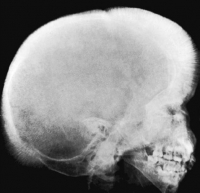I always enjoy the Image Challenge Contest at The New England Journal of Medicine, time ago there was a similar picture of this:

Best viewed in large size
U P D A T E: A nice comment and correct answer by Drmikeunoe
We can see generalized osteopenia, widening of the diploetic space, and thinning of the outer table.
This characteristic “hair on end†appearance of the outer table is compatible with the presence of massive hyperplasia of the bone marrow, as can be seen in the homozygous state of beta-thalassemia (i.e. thalassemia major).
Beta thalassemia syndromes are a group of hereditary disorders characterized by a genetic deficiency in the synthesis of beta-globin chains (adult hemoglobin usually is α2β2) resulting in excess α-chains and severe transfusion-dependent anemia, thus causing bone marrow hyperplasia.
We have seen “hair-on-end” appearance of skull in chronic iron-deficiency anemia, sickle-cell anemia, thalassemia major and cyantic congenital heart disease.
– Prof Suraj Gupte
Head
Postgr Dept of Pediatrics
Narayana Medical College
Nellore, Souith India
Excellent explanation and perfect answer!!
Thank you for your kind comment.
We can see generalized osteopenia, widening of the diploetic space, and thinning of the outer table. This characteristic “hair on end” appearance of the outer table is compatible with the presence of massive hyperplasia of the bone marrow, as can be seen in the homozygous state of beta-thalassemia (i.e. thalassemia major). Beta thalassemia syndromes are a group of hereditary disorders characterized by a genetic deficiency in the synthesis of beta-globin chains (adult hemoglobin usually is α2β2) resulting in excess α-chains and severe transfusion-dependent anemia, thus causing bone marrow hyperplasia.